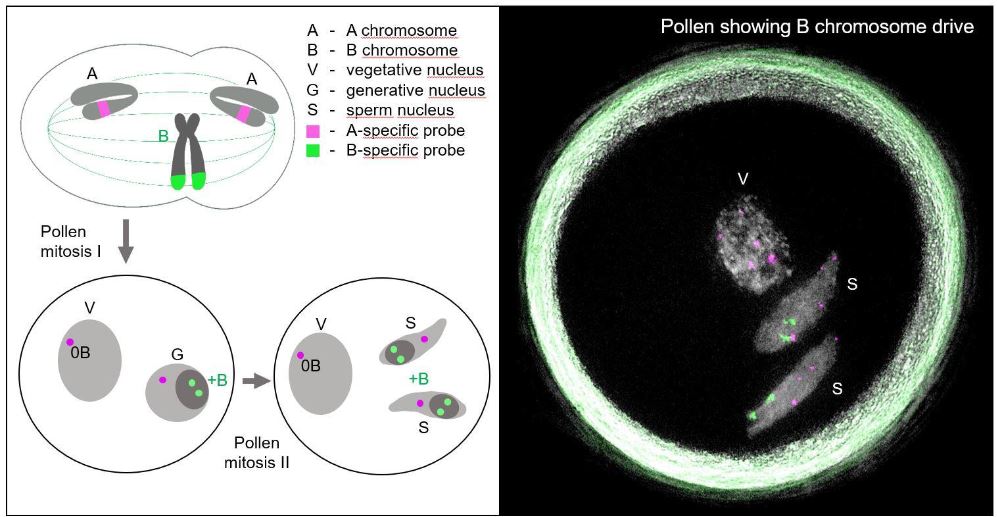Gatersleben, Germany
November 11, 2024
>> IPK-Forschungsteam löst das Rätsel der „egoistischen“ B-Chromosomen im Roggen

The Schema depicts the chromosome drive of the rye B chromosome. The B chromosome sister chromatids undergo nondisjunction during the first pollen mitosis, accumulating in the
generative and sperm nuclei. Cross-section of pollen after in situ detection of A- and B chromosome-specific sequences.
Gatersleben, 11.11.2024 Some chromosomes, such as B chromosomes, can increase their inheritance rate to their own advantage. These extra chromosomes are found in many plants, animals, and fungi and rely upon various strategies to avoid being eliminated over time, as most organisms tend to remove non-essential genetic elements. However, the genetic mechanisms by which B chromosomes avoid elimination are poorly understood. An international research team led by IPK Leibniz Institute identified genes on the rye B chromosome, that are likely responsible for regulating this process. Today, the results were published in the journal “Nature Communications”.
Supernumerary B chromosomes, unlike A (standard) chromosomes, are not required for the normal growth and development of organisms and as of 2024, B chromosomes have been discovered in almost 3,000 species from all eukaryotic phyla. Most B chromosomes confer no detectable selective consequences at low numbers, but increased numbers can result in phenotypic aberrations and reduced fertility. To avoid elimination, many B chromosomes influence cell division in their favour and increase their copy number in the process. This phenomenon is called chromosome drive. The “selfish” B chromosomes, therefore, only become active when their existence is at stake and not for the benefit of the plant.
Drive mechanisms in B chromosome systems have been studied in many species and contexts using various technologies, from classical genetics to cytogenetics. But despite being an ideal test case to study the underlying mechanisms of the chromosome drive, B chromosome research has only slowly been able to capitalise on the data explosion of the DNA sequencing boom: B chromosomes are highly structurally complex, repetitive, and multitudinous, all of which make them resistant to pseudomolecule-level chromosome assembly, especially before recent developments in the area of long-read sequencing. As such, gene-level insight into the specific mechanisms that control chromosome drive is severely limited, and specific gene candidates implicated in this phenomenon have not been identified so far.
To identify drive-controlling factor(s) on the rye B chromosome, an international research team led by the IPK Leibniz Institute first narrowed down the size of the drive-control region. Next, the researchers used long DNA reads and assembled the rye B chromosome into a single ~430 Mb-long pseudomolecule and performed a detailed transcriptome analysis. “Using a newly-assembled B chromosome pseudomolecule, we identified five candidate genes whose role as moderators of chromosome drive is supported by additional studies”, explains Jianyong Chen, first author of the study. “The DCR28 gene, which is presumably responsible for regulating this process, stood out”, emphasises Prof. Andreas Houben, head of IPK’s research group “Chromosome Structure and Function”. Furthermore, it was shown that the B chromosome originated from fragments of all seven rye standard A chromosomes.
These findings could also be helpful for research into genetic diseases that are based on the unequal distribution of chromosomes.
Original publication:
Chen et al. (2024): The genetic mechanism of B chromosome drive in rye illuminated by chromosome-scale assembly. Nature Communications. DOI: 10.1038/s41467-024-53799-w